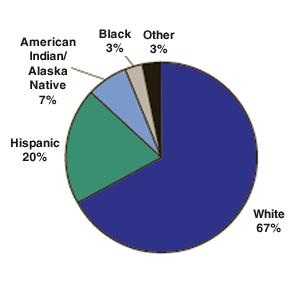

|
March 14, 2002
Adolescent Admissions Involving Inhalants |
|
Inhalants are legal, everyday products whose vapors or gas can be intentionally inhaled to get high. Inhalants include ether, glue, chloroform, nitrous oxide, gasoline, and paint thinner. Use of inhalants among adolescents aged 12 to 17 is a concern because inhalants generally can be legally obtained and use can result in brain damage or death. Primary inhalant abuse accounted for only a small fraction (0.4 percent) of the 131,000 adolescent admissions reported to the Treatment Episode Data Set (TEDS) in 1999. Inhalant abuse among adolescents was more likely to be secondary to marijuana or alcohol abuse. In 1999, while 2,091 adolescents admitted to substance abuse treatment reported abuse of inhalants, only 569 reported inhalants as the primary substance problem. TEDS collects data on national admissions to primarily publicly funded substance abuse treatment facilities, permitting analysis of inhalant-involved adolescent treatment admissions. "Admissions" represent annual treatment episodes rather than the number of individuals entering treatment. |
The number of adolescent admissions to publicly funded substance abuse treatment facilities increased from 109,000 in 1994 to 131,000 in 1999 (data not shown). During that period, the number and proportion of adolescent admissions associated with inhalant abuse declined from 4,731 (4 percent) in 1994 to 2,091 (2 percent) in 1999.
More than half (54 percent) of 1999 adolescent admissions involving inhalant abuse also involved abuse of both alcohol and marijuana (Table 1). Less than 10 percent involved abuse of inhalants alone. Marijuana abuse, either alone or with a drug other than alcohol, was reported in 24 percent of the inhalant-involved adolescent admissions. Alcohol (alone or with a drug other than marijuana) was reported in 10 percent of inhalant-involved adolescent admissions.
The age at initiation of inhalant use showed little change between 1994
and 1999 (Figure 1). Throughout that period, 15 to 20 percent of
inhalant-involved adolescent admissions were younger than age 12 when they first
used inhalants. Some 36 to 37 percent were aged 12 or 13, and 34 to 38 percent
were between 14 and 15 years old at initiation of inhalant use.
|
|
||||||||||||||||||||||
|
 |
Source: 1999
SAMHSA Treatment Episode Data Set (TEDS).
|
Race/Ethnicity In 1999, Whites accounted for approximately two thirds (67
percent) of adolescent admissions involving inhalants (Figure 2).
Hispanics made up one fifth (20 percent) of adolescent admissions
involving inhalants. American Indians/Alaska Natives accounted for 7
percent, and 3 percent were Black or African-American. Source of Referral The source of referral to treatment among adolescents using inhalants varied according to age at admission (Figure 3). About one-third (34 percent) of 12 to 14 year olds entered treatment as the result of a judicial process compared with 49 percent of 15 to 17 year olds. Referrals from school were more likely to occur among 12 to 14 year olds (14 percent) than among 15 to 17 year olds (7 percent). Approximately 20 percent of 12 to 14 year old inhalant-involved admissions resulted from an individual or self referral compared with 14 percent of 15 to 17 year old admissions. |
|
|
||
 |
 |
Source: 1999 SAMHSA Treatment Episode Data Set (TEDS).
For the majority of adolescent admissions involving inhalant abuse, this was the first treatment episode. Among inhalant-involved adolescent male admissions, 61 percent had no prior treatment episodes compared with 69 percent among female admissions (Figure 4). There was little difference between the proportion of male and female adolescent admissions who experienced one prior treatment episode (22 percent and 19 percent, respectively). Some 17 percent of inhalant-involved male adolescent admissions had been in treatment 2 or more times before compared with 12 percent of comparable female admissions.
|
The
Drug and Alcohol Services Information System (DASIS) is an integrated
data system maintained by the Office of Applied Studies, Substance Abuse and
Mental Health Services Administration (SAMHSA). One component of DASIS is
the Treatment Episode Data Set (TEDS), a national-level dataset comprising
State administrative data
primarily
from treatment facilities receiving public funds. The TEDS system includes
records for some 1.6 million substance abuse treatment admissions annually.
TEDS records represent admissions rather than individuals, as a person may
be admitted to treatment more than once.
The DASIS Report is prepared by the Office of Applied Studies, SAMHSA; Synectics for Management Decisions, Inc., Arlington, Virginia; and RTI, Research Triangle Park, North Carolina. Information and data for this issue are based on data reported to TEDS through April 16, 2001.
Access the latest TEDS reports at:
Access the latest TEDS public use files at: |
|
 |
Source: 1999 SAMHSA Treatment Episode Data Set (TEDS).
The DASIS Report is published periodically by the Office of Applied Studies, Substance Abuse and Mental Health Services Administration (SAMHSA). All material appearing in this report is in the public domain and may be reproduced or copied without permission from SAMHSA. Additional copies of this report may be downloaded from
Other reports from the Office of Applied Studies are also available on-line at the OAS home page: http://www.oas.samhsa.gov.
|
This page was last updated on December 31, 2008. |